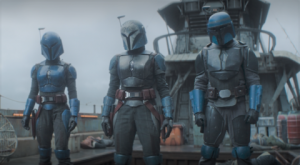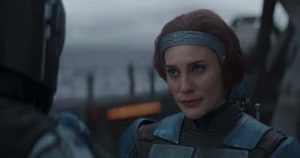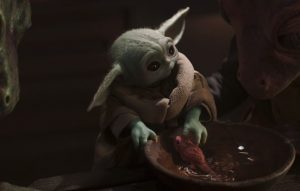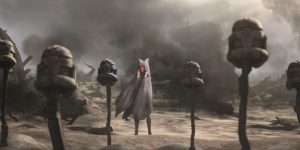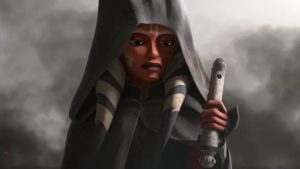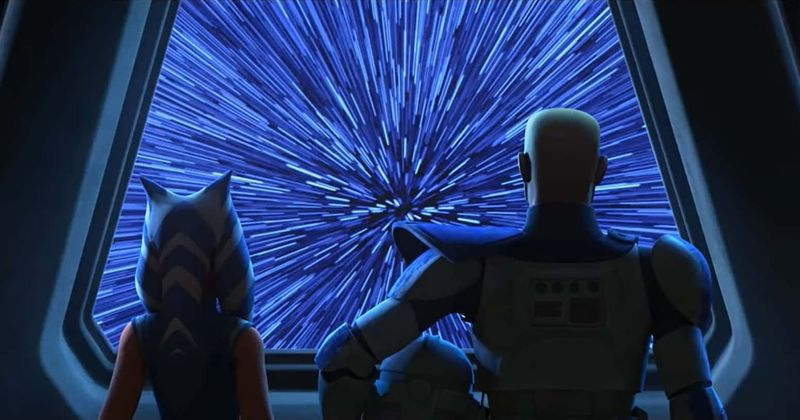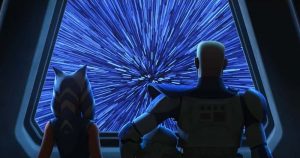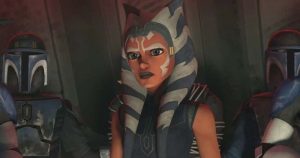SPOILERS FOR THE MANDALORIAN AHEAD!
The hype for The Mandalorian‘s second season has never been higher than after last week’s episode, probably the best in the entire series, when audiences met The Clone Wars‘ Bo-Katan in live-action for the first time, and were promised an upcoming encounter with another fan-favorite from the animated Star Wars universe: Ahsoka Tano, former Jedi turned Rebel spy. But the eight-episode series has found time for another side-quest this week before we actually get to meet Ahsoka – and although it’s a side-quest that does eventually tie back into the actual plot, towards the very end, it might be the final straw for some people. This latest episode hasn’t made it into the top trends of the day on Twitter and it probably ranks among my least favorite “chapters” thus far. The slow pace, something I had hoped to grow more accustomed to this season, still just feels obnoxious and inorganic to me – seriously, how many times are we going to repeat the same exact storyline of Din Djarin (voiced and sometimes played by Pedro Pascal) trying to find a mechanic?

The Mandalorian has never been great at moving the plot forward. When it does move, it takes baby steps. And some people really like that, which is fine. Some people think it gives us more time for worldbuilding and character development; which, to some extent, it does. But never enough, in my opinion, to justify the series’ tedious pacing. The only character who has any development this week is Cara Dune (Gina Carano), and, well…that’s a whole other messy situation.
Gina Carano, a WWE wrestler turned actress, has proven to be more damaging to the Star Wars franchise than I’m sure anyone behind the scenes at Lucasfilm could have anticipated. Last year, when she made her debut in The Mandalorian, she was generally well-received by audiences: sure, she wasn’t all that great an actress, but the driving concept behind her character was intriguing, and it seemed like a fairly decent bit of stunt casting. That was last year. These past few months, Gina Carano has been using her social media platforms (including her newest one, alt-right conspiracy theory forum Parler) to spread dangerous misinformation about everything from the Black Lives Matter movement, to voter fraud, to COVID-19. She got into a prolonged Twitter war with the transgender community after mocking the use of pronouns and putting joke pronouns on her bio. Bizarrely, she also celebrated the birthday of a YouTuber who has attacked her liberal Mandalorian co-star Pedro Pascal in a series of rant videos. I can’t be sure what else she’s said and done more recently, as she blocked me on Twitter not long ago, but I think you get the gist: she’s wildly controversial, and many of us feel that her and her baggage have no place in Star Wars. In some ways, Cara Dune has herself been tainted by the actress’ personal views, and it’s hard to not feel extremely uncomfortable whenever she’s onscreen.
But whether or not Gina Carano sticks around (there has been a steadily growing movement to have her replaced), Dune looks likely to stay – and with a different actress in the role, one who doesn’t make fun of marginalized communities or attempt to undermine democracy, perhaps I’d find her more interesting. After the first season finale, Dune became the Marshal of Nevarro under the administration of Greef Karga (Carl Weathers, who also directed this week’s episode), and we now get to see her doing his dirty work as a brawler, before being approached by her former allies in the New Republic (by Paul Sun-Hyung Lee, no less) and asked to come back and help root out the last Imperials scattered across the galaxy. Although Dune turns down the offer, she seems indecisive, and if she does decide to rejoin the Republic, that would be a good setup for future stories: especially since there’s still a lot of gaps in our knowledge about the New Republic, and how it took over from the Empire, especially in the worlds on the Outer Rim. What Dune would be leaving behind, however, is a good job on a world that seems like it might become a bustling trade hub in the near future, thanks to Din Djarin.
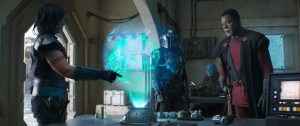
Djarin gets involved in this week’s side-quest mostly out of necessity, after having to land on Nevarro for more repairs (his initial attempt to put Baby Yoda to work ends up getting the child electrocuted), leaving his ship with a suspicious mechanic, and reuniting with Dune and Karga, both of whom he bonded with during his adventures in season one. Karga’s been trying to clean up his act and turn Nevarro into a more respectable planet than it once was: he’s even built a school in the remains of the old saloon where he and Din Djarin battled the Empire. But the one thing he hasn’t been able to do is infiltrate the ex-Imperial fortress outside town where a small garrison of stormtroopers are still hiding out – and that, of course, is where Djarin comes in. He can’t really turn down Karga’s offer, after all. And so, after leaving Baby Yoda at the aforementioned school (where Baby Yoda spends most of the school day using the Force to steal cookies from his unsuspecting classmates), the squad set out in a speeder owned by the very same Mythrol alien (Horatio Sanz) whom Din Djarin took captive in the season one pilot. Froze him in carbon, if I recall correctly, and sold him off for a hefty reward. You would think this might lead to more awkwardly humorous interactions between the two now, but that is unfortunately not the case.
The break-in at the fortress has its moments (including one obviously unintentional blunder, when a Mandalorian crew-member wearing a wristwatch is partly visible behind Greef Karga at exactly 18:54). There’s a riveting chase scene involving speeder bikes and TIE fighters. A small volcano erupts. But by far the most notable events take place in the secret laboratory deep within the fortress: where Din Djarin uncovers a recent hologram message from season one’s minor antagonist Dr. Pershing (Omid Abtahi) to Moff Gideon (Giancarlo Esposito), the ex-Imperial official who has made it his mission to recover Baby Yoda at all costs and…well, we don’t know what he intends to do with the child after that. Presumably something involving cloning, Pershing’s specialty, since the laboratory in the fortress is filled with rows of tanks containing strange, malformed humanoids – including one that some fans think might be an early prototype of Supreme Leader Snoke, a major villain in the sequel trilogy, revealed in The Rise Of Skywalker to be a mutated clone of Emperor Palpatine.
Pershing’s experiments seem to have been developed using a single blood sample he obtained from Baby Yoda back in season one: a blood sample which, in his words, contains an abnormally high “M-count”. While this reference might go over some fans’ heads (it went over mine at first, that’s for sure), this is a nod to one of the most controversial elements of the prequel trilogy: midi-chlorians, ingredients in a person’s genetic code which determine that person’s strength in the Force. The whole concept of midi-chlorians was extraordinarily unpopular back in the day, since it seemed to undermine the idea that the Force was something anyone could wield, so The Mandalorian can’t have brought them back without a very good reason. What seems most likely is that Gideon and Pershing are trying to clone Force-users – perhaps the early stages of a plan to resurrect Palpatine – and understanding midi-chlorians would be essential to getting to the bottom of this nefarious plot. All of this sounds very complicated and very exciting: which makes it even more disappointing that we still don’t have any clear answers, even after this new reveal. If anything, we just have more questions – since the return of midi-chlorians necessitates a re-evaluation of the Force, and more heated arguments about who can and can’t use it.

In the end, the fortress comes down and Nevarro is saved. But Din Djarin has unintentionally landed himself in more trouble, since it turns out that the mechanic he hired is actually a spy working for Moff Gideon, who somehow anticipated the Mandalorian’s arrival and had a tracking beacon ready to attach to the Razor Crest so that Gideon can now follow Djarin and Baby Yoda to their next location – which, presumably, will be the city of Calodan on the forest planet of Corvus, where Djarin has an outstanding appointment with Ahsoka Tano. What are the chances?
(Before I close out this post, I want to briefly inform my readers that today is Transgender Day of Remembrance, the date on which we mourn the transgender lives lost to transphobic violence and bigotry: thus making Gina Carano’s return to Star Wars on this solemn date all the more noticeably awkward and uncomfortable, considering that her own statements and actions – whether intentionally transphobic or willfully ignorant – have made members of the trans community less safe.
To my cisgender readers: please know that being asked for your pronouns isn’t some ridiculous request or an opportunity to make a joke, but is instead a harmless and important sign of allyship with the trans community. My pronouns are he/him/his, for example. And to my transgender readers: please know that I stand with you, and I will listen to you and learn from you, as I continue to strive to make my blog a safer and more welcoming place for people of all gender identities).
Episode Rating: 5/10
